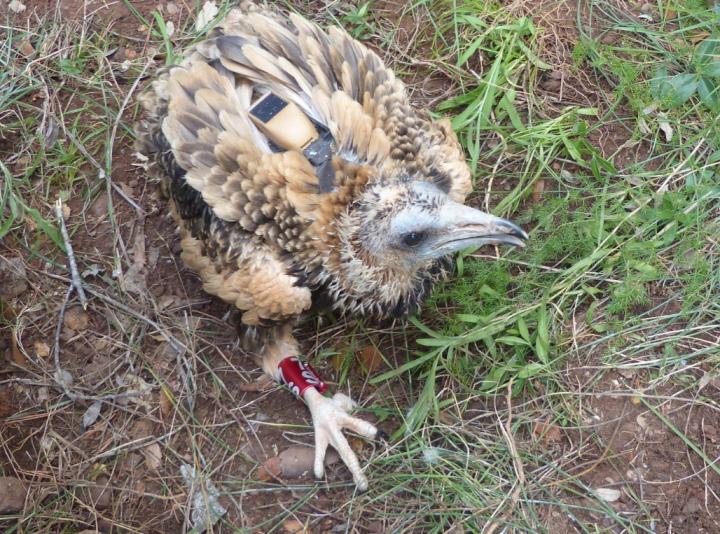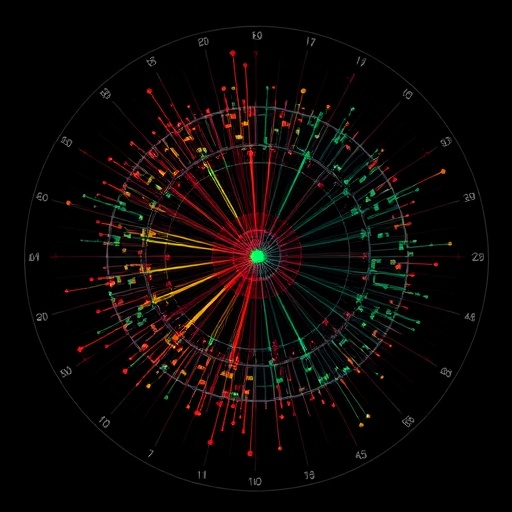Tracking the vultures: a great team work

Credit: Conservation Biology Group (University of Barcelona-IRBio)
Therefore, during the breeding season in 2018, the Conservation Biology Team of the University of Barcelona marked six Egyptian vultures with GPS emitters to conduct its tracking: Ros, Obac, Avenc, Orís, Picatxo and Asticot. The first three birds were born in 2018: Ros and Obac came from the Natural Park of Sant Llorenç del Munt i l’Obac, and Avenc, from Espai Natural de les Guilleries-Savassona. Orís was born in 2017 and came from another recovery center; Picatxo was born in 2016 in la Garrotxa, and Asticot was born in 2014 in southern France. The three last ones formed a group of Egyptian vultures that had been caught and released in Osona.
The GPS-GSM technology allowed the precise tracking of the movements, use of space and migration process of these Egyptian vultures to Africa. “This is one of the first times that GPS-GSM emitters have been used in these species, which is endangered worldwide, with the aim to know about their transcontinental movements and to track their way back to Catalonia in Spring”, says lecturer Joan Real, head of the Conservation Biology Team of the UB. This study was carried out as part of the project “Aplicació de noves tecnologies per conèixer els efectes del canvi global i local en les poblacions ibèriques d’aufrany. Aplicacions per a la conservació”, led by the Conservation Biology Team of the UB, from the Department of Evolutionary Biology, Ecology and Environmental Sciences and the Biodiversity Research Institute (IRBio) of the University of Barcelona. The project, which has the support of Red Eléctrica de España SAU, Fundació Catalunya – La Pedrera and Diputació de Barcelona, counts on the collaboration of other researchers and naturalists, as well as foresters.
Tracking the vultures: a great team work
Placing emitters in vultures was possible thanks to the collaboration of several organisms and naturalists. In this joint action, the Biodiversity and Environment Service of Generalitat de Catalunya provided the authorization for the marking and tracking of vultures, while the Grup de Suport de Muntanya del Cos d’Agents Rurals (mountain support group of foresters) of Generalitat de Catalunya carried out climbing tasks and caught the young birds. Expert Víctor García, member of the Subdirectorate-General of Natural Environment and Forestry of the Ministry for Ecological Transition, captured the vultures and placed the emitters. The Conservation Biology Team of the UB, a distinguished group in the study of threatened birds of prey, conducted the tracking of these vultures, apart from bird ringing them, and took measurements and biological samples. All beings that were found injured or dead were diagnosed by the experts from the Recovery Center on Torreferrussa from Generalitat de Catalunya. Last, the project also received the support of the experts from the Natural Park of Monteserrat, the Natural Park of Sant Llorenç del Munt i l’Obac, the la Garrotxa Volcanic Zone Natural Park, the Natural Area Guilleries-Savassona and the Consortium of Natural Spaces of Ripollès, apart from the foresters of the mentioned places who took part in the tracking of the vulture population.
Migratory behaviour and threats
In a few weeks, the six Egyptian vultures had created a great amount of data regarding the feeding areas, phenology, movements and causes of death. Like in many other raptors, death linked to human activity is a big problem for the preservation of the species. Although the venom used to illegally hunt carnivorous animals is one of the main threats to these raptors, the data brought by the monitoring of the six beings show that other ways such as electrocution with electric lines, can cause deaths and are probably a big threat to the viability of Egyptian vulture populations.
A difficult journey
The destinations of the six Egyptian vultures have been very different. Orís was released in a landfill to ease its contact with other beings from the same species and to find food. This one got used to this place in such a way that one could say it lives in this landfill. This vulture entered a recovery center after leaving the nest and remained there until it was released last Spring, so it could not migrate. This fact could cause the loss of the migratory instinct, since it has not shown any signs of leaving.
As it was expected, Picatxo and Asticot were the most active regarding movement, due their non-breeding condition. During July and August, they carried out movements in a wide area, mainly in Catalonia, and visited feeding areas such as reeds, landfills and areas with extensive livestock. Both coincided in a feeding area for some days before starting the active migration, which was fast. Picatxo crossed the Strait of Gibraltar on August 16, while Asticot did so on September 3. They reached southern Mauritania in a few days. There are no signs of location for the former one, probably due being in an area without GSM coverage. As for the latter, researchers receive its location.
Regarding the young birds, migration took place later, as expected. Once Avenc left the nest, it stayed in the landfill area for some weeks, probably with its progenitors. It started its active migration on September 7 and after a scale of a few days in Catalonia and Aragon, it crossed the Strait on September 18. It is now in the south of Mauritania. The other young birds from Sant Llorenç del Munt i l’Obac have a different ending.
Obac began the active migration in late August and reached Albacete in two days, where it got electrocuted with electric lines. It could survive for several days until it was caught on September 20 by foresters in Castilla-La-Mancha, who brought him to a recovery center. However, researchers do not know if it will fully recover from the injury.
Regarding Ros, it began the active migration in early September and reached southern Spain in a few days, where it stopped for five days. On September 10, while flying over Granada, it had an accident. Although this is under investigation by Environment agents from Junta de Andalucia, the cause of this accident may be due human activity.
In this context, the obtained data, although dramatic in some cases, is important and of great interest to address the challenges of the conservation of this endangered species. Also, within the frame of the project -active from 2017 to 2020-, it is expected to mark more Egyptian vultures with GPS emitters to continue studying how they live and how they get resources, and therefore get more scientific data on their survival and movements.
###
Media Contact
Bibiana Bonmatí
[email protected]
34-934-035-544
Original Source
https:/





